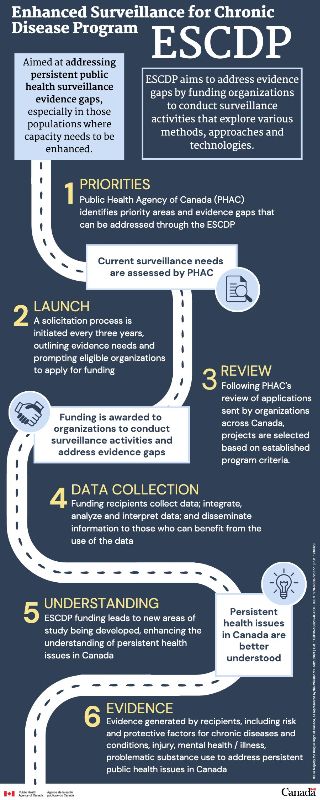Enhanced Surveillance for Chronic Disease Program: About the program
Information about the enhanced surveillance for chronic disease program (ESCDP) and the process behind funding the projects within this program.
- Last modified: 2024-07-16
About the enhanced surveillance for chronic disease program
The Public Health Agency of Canada has the responsibility to enhance surveillance information and expand the knowledge of disease and injury in Canada, including risk factors.
The ESCDP's objective is to enhance capacity for public health, chronic disease and injury surveillance activities by providing grant and contribution funding to:
- Address persistent public health surveillance evidence gaps
- Support the development of a robust evidence base on chronic diseases and conditions, injury, mental health / illness, problematic substance use, and their risk factors in Canada
For this funding program, surveillance means the tracking of health events and determinants through the:
- Ongoing collection of data
- Integration, analysis and interpretation of data
- Dissemination of information to those who can benefit by using the evidence
Surveillance should provide relevant information for public health action.
Funding process
Aimed at addressing persistent public health surveillance evidence gaps, especially in those populations where capacity needs to be enhanced.
There are known health surveillance evidence gaps in Canada. ESCDP addresses these evidence gaps by funding organizations to conduct surveillance activities that explore various methods, approaches and technologies.
- Priorities: Public Health Agency of Canada (PHAC) identifies priority areas and evidence gaps that can be addressed through the ESCDP. Current surveillance needs are assessed by PHAC.
- Launch: A solicitation process is initiated every three years, outlining evidence needs and prompting eligible organizations to apply for funding.
- Review: Following PHAC's review of applications sent by organizations across Canada, projects are selected based on established program criteria. Funding is awarded to organizations to conduct surveillance activities and address evidence gaps.
- Data Collection: Funding recipients collect data; integrate, analyze and interpret data; and disseminate information to those who can benefit from the use of the data.
- Understanding: ESCDP funding leads to new areas of study being developed, enhancing the understanding of persistent health issues in Canada. Persistent health issues in Canada are better understood.
- Evidence: Evidence generated by recipients, including risk and protective factors for chronic diseases and conditions, injury, mental health / illness, problematic substance use to address persistent public health issues in Canada benefit from the use of the data.
- Date modified:
